
Legnica is a city in southwestern Poland, in the central part of Lower Silesia, on the Kaczawa River and the Czarna Woda. As well as being the seat of the county, since 1992 the city has been the seat of the Diocese of Legnica. As of 2023, Legnica had a population of 97,300 inhabitants.

Lower Silesian Voivodeship in southwestern Poland, is one of the 16 voivodeships (provinces) into which Poland is divided. It covers an area of 19,946 square kilometres (7,701 sq mi), and as of 2019 has a total population of 2,899,986.

Brzeg is a town in southwestern Poland with 34,778 inhabitants and the capital of Brzeg County. It is situated in Silesia in the Opole Voivodeship on the left bank of the Oder river.
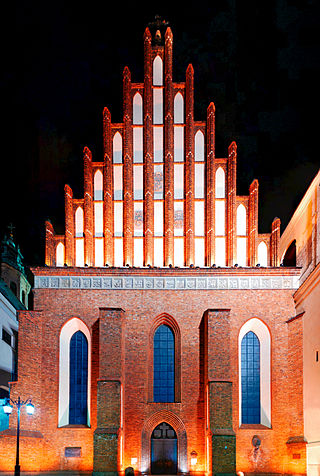
St John's Archcathedral is a Catholic church within the Old Town precinct in Warsaw, Poland. The Brick Gothic structure stands on Świętojańska Street, adjacent to the Jesuit Church. St John's is one of three major cathedrals in the city, but it is the only temple that also possesses the title of an archcathedral. It is the mother church of the Archdiocese of Warsaw and one of Poland's national pantheons. Along with the old city, the church has been listed by UNESCO as a World Heritage Site.
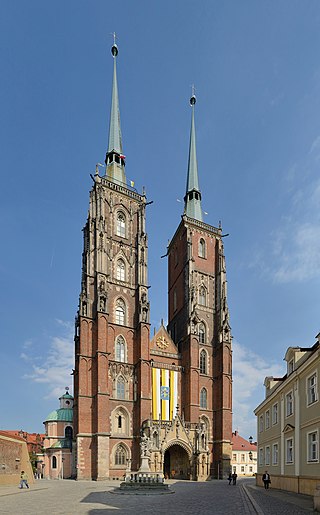
The St. John the Baptist Archcathedral is the seat of the Archdiocese of Wrocław and a landmark of the city of Wrocław in Poland. The cathedral, located in the Cathedral Island, is a Gothic church with Neo-Gothic additions. The current standing cathedral is the fourth church to have been built on the site.

George William, also known as George IV William was the last Silesian duke of Legnica (Liegnitz) and Brzeg (Brieg) from 1672 until his death. He was the last male member of the Silesian Piast dynasty descending from Władysław II the Exile (1105–1159), as well as the last legitimate male member of the entire House of Piast.

Silesian architecture is the name given to the constructions made in Silesia throughout time, and those by Silesian architects worldwide. The name is also applied to buildings made within its geographical limits before the constitution of Silesia as a duchy or before this name was given to those territories, and largely depends on the historical moment. Due to historical, geographic, and generational diversity, Silesian architecture has had a host of influences.

Krzeszów Abbey is a historical Baroque Cistercian monastery in Krzeszów, Lower Silesia, Poland.
The majority of church buildings in Brno belong to the Roman Catholic Church, others mainly to Protestant churches. In addition, there are a synagogue and a mosque. To describe the more notable ones, we can divide Brno into three areas: the city centre, the early suburbs, and former villages and large housing estates incorporated after World War I, including post-World War II developments.
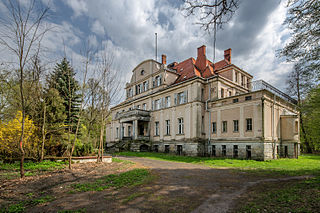
Krzeczyn Wielki is a village in the administrative district of Gmina Lubin, within Lubin County, Lower Silesian Voivodeship, in south-western Poland. The appendix Wielki (Great) serves to distinguish the place from neighbouring Krzeczyn Mały.

Lubiąż Abbey is a former Cistercian monastery in Lubiąż, in the Lower Silesian Voivodeship of southwestern Poland, located about 54 km (34 mi) northwest of Wrocław. The monastery is considered to be one of the largest of its kind with a 223 m long main facade.
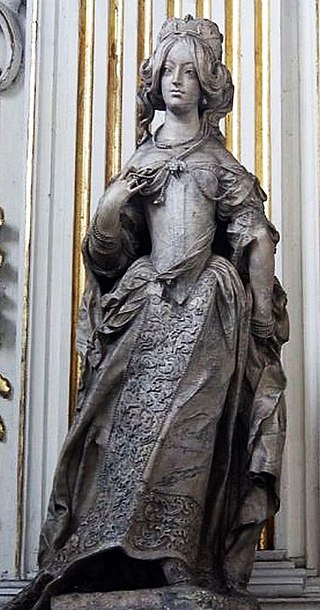
Karolina of Legnica-Brieg-Wohlau, was a Silesian noble, duchess of Legnica, Brzeg and Wołów and the last member of the Silesian Piasts dynasty. She was the eldest daughter of Christian, Duke of Brieg and Louise of Anhalt-Dessau. After the death of her father, she married secretly without the knowledge of her mother on 14 July 1672 to Duke Frederick von Schleswig-Holstein-Sonderburg-Wiesenburg and also became the duchess of Schleswig-Holstein-Sonderburg-Wiesenburg.

Louise of Anhalt-Dessau, was a German princess of the House of Ascania in the branch of Anhalt-Dessau and by marriage Duchess of Legnica, Brzeg, Wołów, and Oława.

The Co-Cathedral of Saint Nicholas in Prešov is one of the oldest and most important churches in Slovakia. The external dimensions of the cathedral are 54.7m in length and 34.45m in width. The indoor nave is 16 m tall and the tower reaches a height of 71 meters. The temple's design takes inspiration from the Late Gothic hall churches with three naves.

Brzeg Castle is located in Brzeg, Opole Voivodeship, Poland. Now a museum, the structures includes the Piast dynasty mausoleum.

The Church of St. Francis is a church adjoining Franciscan convent in Warsaw's New Town.
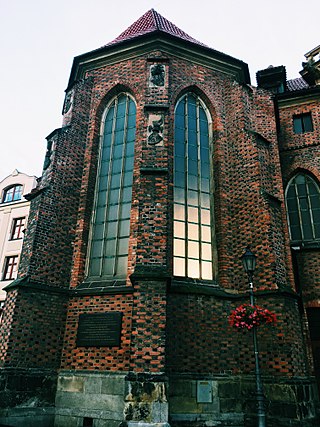
St. Jadwiga's Church in Brzeg, Poland, is a Gothic castle church built in the fourteenth century.

The Castle Chapel in Lubin is located on Mikołaj Pruzio Street on the Castle Hill in Lubin, Poland. The chapel is the only element left from the medieval castle buildings. The date in the tympanum - 1349 - determines the time of construction. It had 3 altars in the 14th century. The chapel was destroyed during the Thirty Years' War, rebuilt in 18th century and fell into ruins again. After reconstruction in the middle of the 19th century it served Catholics until 1908, then it housed a diocesan library. In 1945 it was set on fire. For many years after the war the building remained devastated. In the end of the 1970s the sanctuary was renovated. The chapel was initially managed by the Office of Artistic Exhibitions in Legnica. After the renovation the building was adapted as the Castle Gallery in 1990. In 2005-2009 further renovation works were carried out.

The Collegiate Church of the Assumption of the Blessed Virgin Mary in Głogów is a Roman Catholic church located in the parish of the Assumption of the Blessed Virgin Mary, in Głogów, Poland, within the Diocese of Zielona Góra-Gorzów. It rises above the oldest district of Głogów, Ostrów Tumski. It is currently undergoing reconstruction after damage sustained during World War II. Built in the Romanesque and Gothic styles, it is one of the oldest churches in Silesia and the oldest collegiate church in Silesia. Its origins date back to the first Polish monarchs from the Piast dynasty.
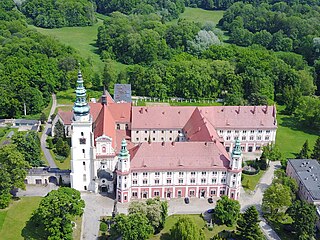
The Cistercian Monastery Complex in Henryków is a post-Cistercian Baroque monastery complex containing the Church of the Assumption of the Blessed Virgin Mary and St. John the Baptist located in Henryków, Poland.





















